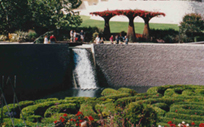Travelogues & History
I’ve spent a lot of time in Washington, D.C., through the years. I was born there in the 1950s, my favorite aunt lived there in the ’60s, one of my brothers lived there through part of the ’70s, business took me to the area frequently in the ’80s and ’90s, and one of my sisters
So far in my Travelogues, I have always reported on watershapes I’ve seen with my own eyes – but every rule needs its exceptions, and this is one of those cases. Many years ago, I became aware of Santiago Calatrava’s extraordinary bridges – structures so far removed from historical precedent and any sense of the ordinary that
Back in 1979, when I first started in magazine publishing and was toiling away as a humble editorial assistant rewriting lots of press releases, the thought of having my own office seemed out of reach. But I was just
In the first entry in this series of articles, we opened a discussion of the hurdles watershapers encounter when attempting to integrate pools or spas with architectural styles that historically never had swimming pools
I’m fairly jaded when it comes to observing watershapes: I’ve seen a lot of them, know how they work and tend to focus on weird details that go beyond what’s perceived by the typical observer. There is, however, a fountain that makes me feel giddy and even
The last time I visited Dallas on business, I kept a crucial side trip in mind: I just had to see the Fort Worth Water Gardens with my own eyes. Designed by New York architects Philip Johnson and John Burgee and completed in 1974, the space has been iconic since day one. The way the space lures you in, drawing you past
What type of swimming pool do you put in the backyard of a Craftsman-style home? This question, presented during a course on 20th-century architecture I taught at the pool show in Las Vegas last November, is easy to ask but difficult to answer. In fact, this is
This is a rather unusual Travelogue: I’d sat down to write a blog about the influence of hotel and resort pools on the way homeowners develop expectations of what can be done in their own backyards, and I recognized almost immediately that
The Getty Center is a true multimedia experience: imposing architecture, lots of people, incredible materials of construction, amazing views, diverse spaces, and rich and varied sounds. Designed by architect Richard Meier, the 750-acre campus is dominated by
When I first began organizing these “Travelogues” several months ago, my sincere intention was to focus on watershapes found within the United States. Partly it was a gesture to the restricted travel budgets of modern times, but I also wanted to highlight the fact that






















